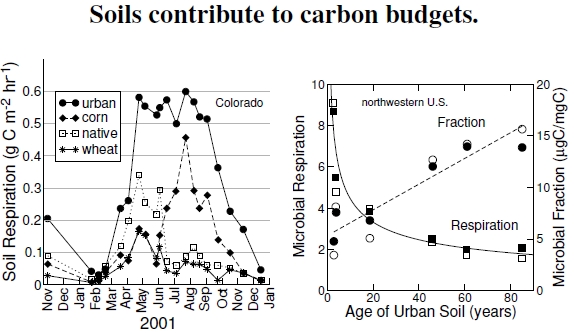3. 9 Soil Carbon
Figure 3.9: The left plot compares soil respiration (CO2 released from microbes in a soil sample) from native grasslands, wheat fields, and irrigated and fertilized corn fields and urban lawns, using three samples from each type from northern Colorado. Urban soils release large amounts of CO2 through enhanced respiration (after Kaye et al. 2005). At right, urban soils take time to recover, from the microbial perspective, after “urbanization” (after Scharenbroch et al. 2005). These samples came from Moscow, Idaho, and Pullman, Washington, in a variety of urban situations in years 2002 (filled symbols) and 2003 (open symbols). Recently urbanized soils have relatively high respiration in response. Older urban soils are better developed, having greater microbial carbon content with longer times since urbanization. Microbial activity roughly represents μg respiration of CO2 per hour per mg of microbial carbon in a soil sample.
Lest we forget what all these plants rest on, climate change involves soils. Ecological communities within soils are part of the carbon cycle, returning carbon to the atmosphere by breaking down dead plants through respiration. Typically, one measures how much CO2 comes out of a soil sample, reflecting the amount of microbial activity taking place in the sample. In the end, urbanization affects soil ecology.
In the left plot of Figure 3.9, soils from wheat and corn fields are compared with native grasslands and urban environments.[48] Within the urban treatment itself, three urban sites were examined: one institutional, one rental dwelling, and one owner-occupied house. Kentucky bluegrass, Poa pratensis, dominated lawns at all three sites. Urban sites were also irrigated, fertilized, and surrounded by trees. In addition to higher respiration rates, urban soil samples have much greater organic carbon and total nitrogen. Furthermore, urban environments had much greater net primary production than the other sites (except for corn), and a much greater allocation of carbon to below-ground biomass.
As an order-of-magnitude calculation, let’s say respiration by urban soils amounts to about 0.25 grams of carbon per square meter per hour averaged over the day and year. For the entire year, this value gives a total respiration of about 2 kg of carbon per square meter per year. If we were expecting a balance between plant growth and soil respiration, this number exceeds NPP values in Figure 1.2. Even compared to fossil-fuel emissions, land-use change contributes a lot of carbon to the atmosphere. Through burning fossil fuels, humans have released 270±30 petagrams (Pg; 1012 kg) of carbon. At the same time, transformation from rural to urban land use increased soil respiration to the tune of 136±55 Pg. Of this urban respiration, 78±12 Pg have been released from the dark, organic matter stored in the ground, degrading urban soils.
However, urban soils recover from the developmental insult of removed vegetation and topsoil, compression from heavy vehicles, and plantings of grass. Shown in the right plot, results from two northwestern states, Idaho and Washington, demonstrate that, in response to urbanization, microbial activity was initially quite high, gradually reducing to levels seen in other environments.[49] At this later stage, soil respiration balances net primary production inputs through dead organic matter. Besides a calmed-down microbial activity as urban soils age, organic carbon increases, and the results here show that microbial fraction increases, too.
All in all, humans can’t forget soils when dealing with increasing temperatures and CO2 concentrations: It’s estimated that with improved soil management soils could sequester 0.6 to 1.2 Pg C per year.[50]
—————————
[48]Kaye et al. (2005) compare urban, rural, and native soil respiration. Data points are averages of 6 or 12 samples taken within each month. Pouyat et al. (2006) report urban soil carbon content varying from 1.5 to 16.3 kgC/m2.
[49]Temporal development of urban soils in Idaho and Washington is described in Scharenbroch et al. (2005). My use of microbial activity paraphrases their technical term, metabolic quotient. Their units involve respiration from soil samples and estimates of relative microbial carbon content, two much more complicated measurements than what my simple phrase implies.
[50]Lal (2003) discusses repiration and sequestration of carbon in soils.
